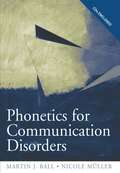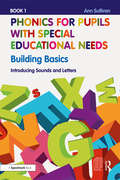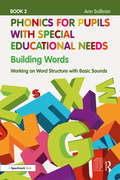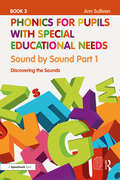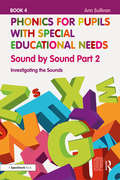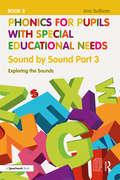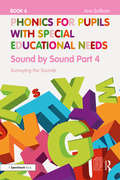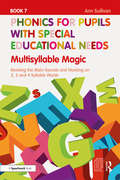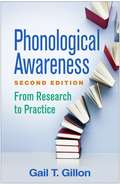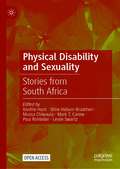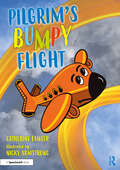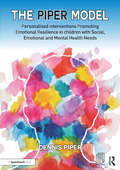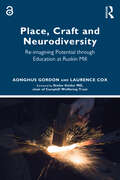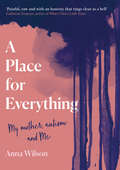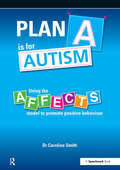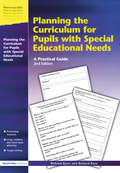- Table View
- List View
Phonetics for Communication Disorders
by Martin J. Ball Nicole MullerThis comprehensive textbook offers a basic introduction to phonetics in an applied systematic presentation that equips the communication disorders student to deal with the wide range of speech types that will be encountered in a clinic. While the major discussion is articulatory, speech acoustics are also examined. Illustrations of sample spectrograms appear in tandem with the more traditional articulatory drawings. Two CDs of sound examples accompany the textbook. This comprehensive textbook offers a basic introduction to phonetics in an applied systematic presentation that equips the communication disorders student to deal with the wide range of speech types that will be encountered in a clinic. While the major discussion is articulatory, speech acoustics
Phonics for Pupils with Special Educational Needs Book 1: Introducing Sounds and Letters (Phonics for Pupils with Special Educational Needs)
by Ann SullivanPhonics for Pupils with Special Educational Needs is a complete, structured, multisensory programme for teaching reading and spelling, making it fun and accessible for all. This fantastic seven-part resource offers a refreshingly simple approach to the teaching of phonics, alongside activities to develop auditory and visual perceptual skills. Specifically designed to meet the needs of pupils of any age with special educational needs, the books break down phonics into manageable core elements and provide a huge wealth of resources to support teachers in teaching reading and spelling. Book 1: Building Basics introduces basic sounds and explores their relationship with letters. It focuses on sounds and letters where there is a simple 1:1 correspondence between the two, and explores the sounds in simple words that follow the pattern of vowel-consonant or consonant-vowel-consonant. Sounds are grouped into seven sets, with each set containing more than 50 engaging activities, including: sound story, dynamic blending, reading race, spot the word and spelling challenge. Thorough guidance is provided on how to deliver each activity, as well as a lesson planner template, handy word lists and posters for teachers and teaching assistants to use to support learning. Each book in the series gradually builds on children’s understanding of sounds and letters and provides scaffolded support for children to learn about every sound in the English language. Offering tried and tested material which can be photocopied for each use, this is an invaluable resource to simplify phonics teaching for teachers and teaching assistants and provide fun new ways of learning phonics for all children.
Phonics for Pupils with Special Educational Needs Book 2: Working on Word Structure with Basic Sounds (Phonics for Pupils with Special Educational Needs)
by Ann SullivanPhonics for Pupils with Special Educational Needs is a complete, structured, multisensory programme for teaching reading and spelling, making it fun and accessible for all. This fantastic seven-part resource offers a refreshingly simple approach to the teaching of phonics, alongside activities to develop auditory and visual perceptual skills. Specifically designed to meet the needs of pupils with special educational needs of any age, the books break down phonics into manageable core elements and provide a huge wealth of resources to support teachers in teaching reading and spelling. Book 2: Building Words reinforces pupils’ knowledge of the basic sounds explored in Book 1 and uses these to build words with a more complex structure. It focuses on words of three, four and five sounds, and words are grouped according to their pattern of vowels and consonants. Each chapter contains more than 50 engaging activities, including: odd one out, sound boxes, busy words, oops! correct the spelling and writing challenge. An additional chapter on capital letters allows pupils to practice identifying and working with these letters. Thorough guidance is provided on how to deliver each activity, as well as a lesson planner template, handy word lists and posters for teachers to use to support learning. Each book in the series gradually builds on children’s understanding of sounds and letters and provides scaffolded support for children to learn about every sound in the English language. Offering tried and tested material which can be photocopied for each use, this is an invaluable resource to simplify phonics teaching for teachers and teaching assistants and provide fun new ways of learning phonics for all children.
Phonics for Pupils with Special Educational Needs Book 3: Discovering the Sounds (Phonics for Pupils with Special Educational Needs)
by Ann SullivanPhonics for Pupils with Special Educational Needs is a complete, structured, multisensory programme for teaching reading and spelling, making it fun and accessible for all. This fantastic seven-part resource offers a refreshingly simple approach to the teaching of phonics, alongside activities to develop auditory and visual perceptual skills. Specifically designed to meet the needs of pupils with special educational needs of any age, the books break down phonics into manageable core elements and provide a huge wealth of resources to support teachers in teaching reading and spelling. Book 3: Sound by Sound, Part 1 focuses on discovering complex sounds and their relationship with letters and letter combinations. Each chapter explores a key sound (sh/ th/ ng/ ch/ k/ qu/ f/ l/ s) and contains over 40 engaging activities, including: sound exchange, word scramble, spot the spelling, word detective and writing challenge. Thorough guidance is provided on how to deliver each activity, as well a lesson planner template, a handy list of high frequency words and posters for teachers and teaching assistants to use to support learning. Each book in the series gradually builds on children’s understanding of sounds and letters and provides scaffolded support for children to learn about every sound in the English language. Offering tried and tested material which can be photocopied for each use, this is an invaluable resource to simplify phonics teaching for teachers and teaching assistants and provide fun new ways of learning phonics for all children.
Phonics for Pupils with Special Educational Needs Book 4: Investigating the Sounds (Phonics for Pupils with Special Educational Needs)
by Ann SullivanPhonics for Pupils with Special Educational Needs is a complete, structured, multisensory programme for teaching reading and spelling, making it fun and accessible for all. This fantastic seven-part resource offers a refreshingly simple approach to the teaching of phonics, alongside activities to develop auditory and visual perceptual skills. Specifically designed to meet the needs of pupils of any age with special educational needs, the books break down phonics into manageable core elements and provide a huge wealth of resources to support teachers in teaching reading and spelling. Book 4: Sound by Sound Part 2 focuses on investigating complex sounds and their relationship with letters and letter combinations. Each chapter explores a key sound (o-e/ z/ ee/ a-e/ er/ e/ ow) and contains over 40 engaging activities, including: sound sums, word tech, word tracker, making better sentences and spelling challenge. Thorough guidance is provided on how to deliver each activity, as well a lesson planner template, a handy list of high frequency words and posters for teachers and teaching assistants to use to support learning. Each book in the series gradually builds on children’s understanding of sounds and letters and provides scaffolded support for children to learn about every sound in the English language. Offering tried and tested material which can be photocopied for each use, this is an invaluable resource to simplify phonics teaching for teachers and teaching assistants and provide fun new ways of learning phonics for all children.
Phonics for Pupils with Special Educational Needs Book 5: Exploring the Sounds (Phonics for Pupils with Special Educational Needs)
by Ann SullivanPhonics for Pupils with Special Educational Needs is a complete, structured, multisensory programme for teaching reading and spelling, making it fun and accessible for all. This fantastic seven-part resource offers a refreshingly simple approach to the teaching of phonics, alongside activities to develop auditory and visual perceptual skills. Specifically designed to meet the needs of pupils of any age with special educational needs, the books break down phonics into manageable core elements and provide a huge wealth of resources to support teachers in teaching reading and spelling. Book 5: Sound by Sound Part 3 focuses on exploring complex sounds and their relationship with letters and letter combinations. Each chapter explores a key sound (oy/ oo/ u/ i-e/ aw/ air/ ar) and contains over 40 engaging activities, including: reading race, bits missing, spot the spelling, word detective and writing challenge. Thorough guidance is provided on how to deliver each activity, as well a lesson planner template, a handy list of high frequency words and posters for teachers and teaching assistants to use to support learning. Each book in the series gradually builds on children’s understanding of sounds and letters and provides scaffolded support for children to learn about every sound in the English language. Offering tried and tested material which can be photocopied for each use, this is an invaluable resource to simplify phonics teaching for teachers and teaching assistants and provide fun new ways of learning phonics for all children.
Phonics for Pupils with Special Educational Needs Book 6: Surveying the Sounds (Phonics for Pupils with Special Educational Needs)
by Ann SullivanPhonics for Pupils with Special Educational Needs is a complete, structured, multisensory programme for teaching reading and spelling, making it fun and accessible for all. This fantastic seven-part resource offers a refreshingly simple approach to the teaching of phonics, alongside activities to develop auditory and visual perceptual skills. Specifically designed to meet the needs of pupils of any age with special educational needs, the books break down phonics into manageable core elements and provide a huge wealth of resources to support teachers in teaching reading and spelling. Book 6: Sound by Sound Part 4 focuses on surveying complex sounds and their relationship with letters and letter combinations. Each chapter explores a key sound (s/ l/ b&d/ o/ i/ u-e) as well as looking at consonants in greater detail and contains over 40 engaging activities including sound story, flippies, sound swap, word tech and spelling challenge. Thorough guidance is provided on how to deliver each activity, as well a lesson planner template, a handy list of high frequency words and posters for teachers and teaching assistants to use to support learning. Each book in the series gradually builds on children’s understanding of sounds and letters and provides scaffolded support for children to learn about every sound in the English language. Offering tried and tested material which can be photocopied for each of use, this is an invaluable resource to simplify phonics teaching for teachers and teaching assistants and provide fun new ways of learning phonics for all children.
Phonics for Pupils with Special Educational Needs Book 7: Revising the Main Sounds and Working on 2, 3 and 4 Syllable Words (Phonics for Pupils with Special Educational Needs)
by Ann SullivanPhonics for Pupils with Special Educational Needs is a complete, structured, multisensory programme for teaching reading and spelling, making it fun and accessible for all. This fantastic seven-part resource offers a refreshingly simple approach to the teaching of phonics, alongside activities to develop auditory and visual perceptual skills. Specifically designed to meet the needs of pupils of any age with special educational needs, the books break down phonics into manageable core elements and provide a huge wealth of resources to support teachers in teaching reading and spelling. Book 7: Multisyllable Magic focuses on revising the main complex sounds from previous books and working on words with 2, 3 and 4 syllables. It also explores words with key suffixes (-tion/ -sion/ -ture/ -sure/ -cious/ -cial). Each chapter contains 10 engaging activities, including syllable jigsaw, sounds like a syllable, syllable trap and spelling challenge, plus handy highlighted word cards. Thorough guidance is provided on how to deliver each activity, as well as a lesson planner template to support learning. Each book in the series gradually builds on children’s understanding of sounds and letters and provides scaffolded support for children to learn about every sound in the English language. Offering tried and tested material which can be photocopied for each use, this is an invaluable resource to simplify phonics teaching for teachers and teaching assistants and provide fun new ways of learning phonics for all children.
Phonological Awareness,: From Research To Practice (2nd edition) (PDF)
by Gail T. GillonTranslating cutting-edge research into practical recommendations for assessment and instruction, this book has helped thousands of readers understand the key role of phonological awareness in the development of reading, writing, and spelling. It clearly shows how children's knowledge about the sound structure of spoken language contributes to literacy acquisition. Evidence-based strategies are described for enhancing all learners' phonological awareness and effectively supporting those who are struggling (ages 3–17). The book discusses ways to tailor instruction and intervention for a broad range of students, including English language learners (ELLs) and those with reading or language disorders. New to This Edition: *Incorporates over a decade of important advances in research, assessment, and instruction. *Chapter on ELLs, plus additional insights on ELLs woven throughout the book, including new case studies. *Chapter on spelling development. *Significantly revised coverage of children with complex communication needs.
Physical Disability and Sexuality: Stories from South Africa
by Leslie Swartz Poul Rohleder Xanthe Hunt Stine Hellum Braathen Mussa Chiwaula Mark T. CarewThis open access edited volume explores physical disability and sexuality in South Africa, drawing on past studies, new research conducted by the editors, and first-person narratives from people with physical disabilities in the country. Sexuality has long been a site of oppression and discrimination for people with disabilities based on myths and misconceptions, and this book explores how these play out for people with physical disabilities in the South African setting. One myth with which the book is centrally concerned, is that people with disabilities are unable to have sex, or are seen as lacking sexuality by society at large. Societal understandings of masculinity, femininity, bodies and attractiveness, often lead people with physical disabilities to be seen as being undesirable romantic or sexual partners. The contributions in this volume explore how these prevailing social conditions impact on the access to sexual and reproductive healthcare, involvement in romantic relationships, childbearing, and sexual citizenship as a whole, of people with physical disabilities in the Western Cape of the country. The authors' research, and first person contributions by people with physical disabilities themselves, suggest that education and public health policy must change, if the sexual and reproductive health rights and full inclusion of people with disabilities are to be achieved.
Pilgrim's Bumpy Flight: Helping Young Children Learn About Domestic Abuse Safety Planning (Safety Planning with Young Children)
by Catherine LawlerFor effective and safe use, this book should be purchased alongside the professional guidebook. Both books can be purchased together as a set, Domestic Abuse Safety Planning with Young Children: A 'Pilgrim’s Bumpy Flight' Storybook and Professional Guide [9781032357997] Pilgrim is a little plane who loves flying through the sky and zooming through big hoops with their friends. At home, however, Pilgrim experiences frightening behaviour from Jumbo, who represents the perpetrating parent, that makes them feel scared and sad. Pilgrim is comforted and guided by Jet, who represents the victim/survivor parent, to think about safety and what to do when frightening things are happening. The trauma a young child may experience from domestic abuse can impact their entire developing system, making them feel worried, frightened, and unsafe. Safety planning is an essential component of direct work with children, offering a way to help them vocalise their feelings and understand what to do when something does not feel right, and this storybook is a key vessel for communication and exploration. The story, which is rhyming and engaging, enables young children to engage in the narrative in a non-threatening way. This book aims to be accessible to all children from all families where safety planning is needed as such the characters in it are non-gendered. This beautifully illustrated storybook is a crucial tool for the early years sector, education staff and those working in children’s services, including safeguarding officers, family support workers, social workers and children’s IDVAs. This book is designed to be used alongside the companion guidebook, Domestic Abuse Safety Planning with Young Children: A Professional Guide. Both books should be used in tandem with agency policy, procedure and guidance.
Pip and Bunny: Pip at the Seaside (Supporting Language and Emotional Development in the Early Years through Reading)
by Maureen GlynnPip at the Seaside is the fourth book in the invaluable ‘Pip and Bunny’ collection; a set of six picture books with an accompanying handbook and e-resources carefully written and illustrated to support the development of visual and literary skills. By inspiring conversation and imagination, the books promote emotional and social literacy in the young reader. Designed for use within the early years setting or at home, each story explores different areas of social and emotional development. The full set includes: six beautifully illustrated picture books with text and vocabulary for each a handbook designed to guide the adult in using the books effectively ‘Talking Points’ relating to the child’s own world ‘What’s the Word?’ picture pages to be photocopied, downloaded or printed for language development detailed suggestions as to how to link with other EYFS areas of learning. The set is designed to be used in both individual and group settings. It will be a valuable resource for teachers, SENCOs (pre-school and reception), Early Years Staff (nursery, preschool and reception), EOTAs, Educational Psychologists, Counsellors and Speech Therapists.
Pip and Bunny: Pip’s Dream (Supporting Language and Emotional Development in the Early Years through Reading)
by Maureen GlynnPip’s Dream is the first book in the invaluable ‘Pip and Bunny’ collection; a set of six picture books with an accompanying handbook and e-resources carefully written and illustrated to support the development of visual and literary skills. By inspiring conversation and imagination, the books promote emotional and social literacy in the young reader. Designed for use within the early years setting or at home, each story explores different areas of social and emotional development. The full set includes: six beautifully illustrated picture books with text and vocabulary for each a handbook designed to guide the adult in using the books effectively ‘Talking Points’ relating to the child’s own world ‘What’s the Word?’ picture pages to be photocopied, downloaded or printed for language development detailed suggestions as to how to link with other EYFS areas of learning. The set is designed to be used in both individual and group settings. It will be a valuable resource for teachers, SENCOs (pre-school and reception), Early Years Staff (nursery, preschool and reception), EOTAs, Educational Psychologists, Counsellors and Speech Therapists.
Pip and Bunny: Bunny Visits London (Supporting Language and Emotional Development in the Early Years through Reading)
by Maureen GlynnBunny Visits London is the third book in the invaluable ‘Pip and Bunny’ collection; a set of six picture books with an accompanying handbook and e-resources carefully written and illustrated to support the development of visual and literary skills. By inspiring conversation and imagination, the books promote emotional and social literacy in the young reader. Designed for use within the early years setting or at home, each story explores different areas of social and emotional development. The full set includes: six beautifully illustrated picture books with text and vocabulary for each a handbook designed to guide the adult in using the books effectively ‘Talking Points’ relating to the child’s own world ‘What’s the Word?’ picture pages to be photocopied, downloaded or printed for language development detailed suggestions as to how to link with other EYFS areas of learning. The set is designed to be used in both individual and group settings. It will be a valuable resource for teachers, SENCOs (pre-school and reception), Early Years Staff (nursery, preschool and reception), EOTAs, Educational Psychologists, Counsellors and Speech Therapists.
Pip and Bunny: Pip and the Flyaway Balloon (Supporting Language and Emotional Development in the Early Years through Reading)
by Maureen GlynnPip and the Flyaway Balloon is the second book in the invaluable ‘Pip and Bunny’ collection; a set of six picture books with an accompanying handbook and e-resources carefully written and illustrated to support the development of visual and literary skills. By inspiring conversation and imagination, the books promote emotional and social literacy in the young reader. Designed for use within the early years setting or at home, each story explores different areas of social and emotional development. The full set includes: six beautifully illustrated picture books with text and vocabulary for each a handbook designed to guide the adult in using the books effectively ‘Talking Points’ relating to the child’s own world ‘What’s the Word?’ picture pages to be photocopied, downloaded or printed for language development detailed suggestions as to how to link with other EYFS areas of learning. The set is designed to be used in both individual and group settings. It will be a valuable resource for teachers, SENCOs (preschool and reception), Early Years Staff (nursery, pre-school and reception), EOTAs, Educational Psychologists, Counsellors and Speech Therapists.
Pip and Bunny: The Cheeky Ostrich (Supporting Language and Emotional Development in the Early Years through Reading)
by Maureen GlynnThe Cheeky Ostrich is the fifth book in the invaluable ‘Pip and Bunny’ collection; a set of six picture books with an accompanying handbook and e-resources carefully written and illustrated to support the development of visual and literary skills. By inspiring conversation and imagination, the books promote emotional and social literacy in the young reader. Designed for use within the early years setting or at home, each story explores different areas of social and emotional development. The full set includes: six beautifully illustrated picture books with text and vocabulary for each a handbook designed to guide the adult in using the books effectively ‘Talking Points’ relating to the child’s own world ‘What’s the Word?’ picture pages to be photocopied, downloaded or printed for language development detailed suggestions as to how to link with other EYFS areas of learning. The set is designed to be used in both individual and group settings. It will be a valuable resource for teachers, SENCOs (pre-school and reception), Early Years Staff (nursery, preschool and reception), EOTAs, Educational Psychologists, Counsellors and Speech Therapists.
Pip and Bunny: Pip at Home (Supporting Language and Emotional Development in the Early Years through Reading)
by Maureen GlynnPip at Home is the sixth book in the invaluable ‘Pip and Bunny’ collection; a set of six picture books with an accompanying handbook and e-resources carefully written and illustrated to support the development of visual and literary skills. By inspiring conversation and imagination, the books promote emotional and social literacy in the young reader. Designed for use within the early years setting or at home, each story explores different areas of social and emotional development. The full set includes: six beautifully illustrated picture books with text and vocabulary for each a handbook designed to guide the adult in using the books effectively ‘Talking Points’ relating to the child’s own world ‘What’s the Word?’ picture pages to be photocopied, downloaded or printed for language development detailed suggestions as to how to link with other EYFS areas of learning. The set is designed to be used in both individual and group settings. It will be a valuable resource for teachers, SENCOs (pre-school and reception), Early Years Staff (nursery, preschool and reception), EOTAs, Educational Psychologists, Counsellors and Speech Therapists.
Pip and Bunny: Pip at Home (Supporting Language and Emotional Development in the Early Years through Reading)
by Maureen GlynnPip at Home is the sixth book in the invaluable ‘Pip and Bunny’ collection; a set of six picture books with an accompanying handbook and e-resources carefully written and illustrated to support the development of visual and literary skills. By inspiring conversation and imagination, the books promote emotional and social literacy in the young reader. Designed for use within the early years setting or at home, each story explores different areas of social and emotional development. The full set includes: six beautifully illustrated picture books with text and vocabulary for each a handbook designed to guide the adult in using the books effectively ‘Talking Points’ relating to the child’s own world ‘What’s the Word?’ picture pages to be photocopied, downloaded or printed for language development detailed suggestions as to how to link with other EYFS areas of learning. The set is designed to be used in both individual and group settings. It will be a valuable resource for teachers, SENCOs (pre-school and reception), Early Years Staff (nursery, preschool and reception), EOTAs, Educational Psychologists, Counsellors and Speech Therapists.
The Piper Model: Personalised Interventions Promoting Emotional Resilience in children with Social, Emotional and Mental Health Needs
by Dennis PiperThis book is intended to be both a practical evidence-based tool and an awareness-raising resource for teachers, teaching assistants, mentors and all adults who work with children and young people who present as 'extremely challenging' in the school context. In every school there are a small number of pupils, less than five percent, who take up more than fifty percent of the staff's time. This book provides school staff with an approach to personalised interventions that enable those children or young people to build life-long resilience skills.
The Piper Model: Personalised Interventions Promoting Emotional Resilience in children with Social, Emotional and Mental Health Needs
by Dennis PiperThis book is intended to be both a practical evidence-based tool and an awareness-raising resource for teachers, teaching assistants, mentors and all adults who work with children and young people who present as 'extremely challenging' in the school context. In every school there are a small number of pupils, less than five percent, who take up more than fifty percent of the staff's time. This book provides school staff with an approach to personalised interventions that enable those children or young people to build life-long resilience skills.
Place, Craft and Neurodiversity: Re-imagining Potential through Education at Ruskin Mill
by Aonghus Gordon Laurence CoxFor over four decades, Ruskin Mill Trust has worked with young people with special educational needs and behavioural issues who learn traditional crafts and organic farming as part of an integrated curriculum of therapeutic education, overcoming barriers to learning and re-engaging with the wider world. This accessible and inspiring book showcases how an appreciation of place, traditional crafts, farming and transformative education offers a wider route to human well-being for all. The authors outline the different fields of the “Practical Skills Therapeutic Education” method, which includes developing practical skills, learning the ecology of the farm and understanding therapeutic education, holistic care, health and self-leadership. Taking the reader on a tour of Ruskin Mill’s many extraordinary provisions across Britain, and going deeper in conversation with its founder, Aonghus Gordon, this book is an outstanding story of creative thinking in an age of narrow focus on classrooms and written examinations, presenting a transformative perspective on education and care. Being grounded in work supporting young people with complex additional needs, it provides a rare insight into the work of one of the world’s leading charities working with neurodiversity. With its non-specialist language, Place, Craft and Neurodiversity offers ideas and resources for work in different areas of education and therapy. It will inspire parents, educators and care workers around the globe.
Place, Craft and Neurodiversity: Re-imagining Potential through Education at Ruskin Mill
by Aonghus Gordon Laurence CoxFor over four decades, Ruskin Mill Trust has worked with young people with special educational needs and behavioural issues who learn traditional crafts and organic farming as part of an integrated curriculum of therapeutic education, overcoming barriers to learning and re-engaging with the wider world. This accessible and inspiring book showcases how an appreciation of place, traditional crafts, farming and transformative education offers a wider route to human well-being for all. The authors outline the different fields of the “Practical Skills Therapeutic Education” method, which includes developing practical skills, learning the ecology of the farm and understanding therapeutic education, holistic care, health and self-leadership. Taking the reader on a tour of Ruskin Mill’s many extraordinary provisions across Britain, and going deeper in conversation with its founder, Aonghus Gordon, this book is an outstanding story of creative thinking in an age of narrow focus on classrooms and written examinations, presenting a transformative perspective on education and care. Being grounded in work supporting young people with complex additional needs, it provides a rare insight into the work of one of the world’s leading charities working with neurodiversity. With its non-specialist language, Place, Craft and Neurodiversity offers ideas and resources for work in different areas of education and therapy. It will inspire parents, educators and care workers around the globe.
A Place for Everything
by Anna Wilson‘Painful, raw and with an honesty that rings clear as a bell’ Catherine Simpson, author of When I Had a Little Sister A searing account of a mother’s late-diagnosis of autism – and its reaching effects on a whole family.
Plan A is for Autism: Using the Affects Model to Promote Positive Behaviour
by Caroline SmithThis text provides an original multi-element approach leading to planned individual interventions. Drawn from the author's extensive knowledge of autism it enables those living and working with children with Autism Spectrum Disorders (ASD) to jointly plan for change. This resource will: provide an overview of the behaviours of children with autism explore the underlying reasons why children with autism act and react as they do consider quite carefully who is impacted by the behaviour of the child with autism with what outcomes for emotional well-being explore how to make a difference in the shorter term by using the Keep It Simple (KIP) model help you to implement a unique and individual intervention plan for the child with autism using the AFFECTS plan
Planning the Curriculum for Pupils with Special Educational Needs: A Practical Guide (Resource Materials for Teachers)
by Richard Byers Richard RoseThis second edition is revised and updated to take full account of recent developments in special needs. The core of the book focuses on planning for well-differentiated curriculum implementation. It describes a variety of models that explore progression, continuity, relevance and inclusion for pupils with special educational needs. The authors also offer an analysis of curriculum management issues in the light of the theoretical and statutory background since the latest revisions of the National Curriculum and the Code of Practice.
